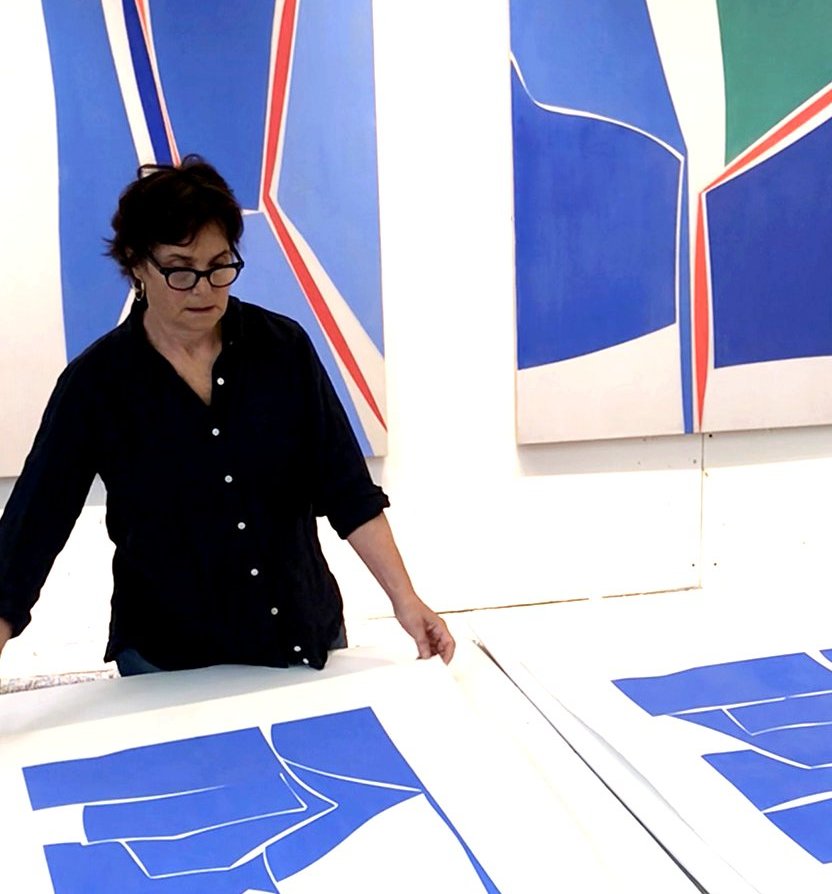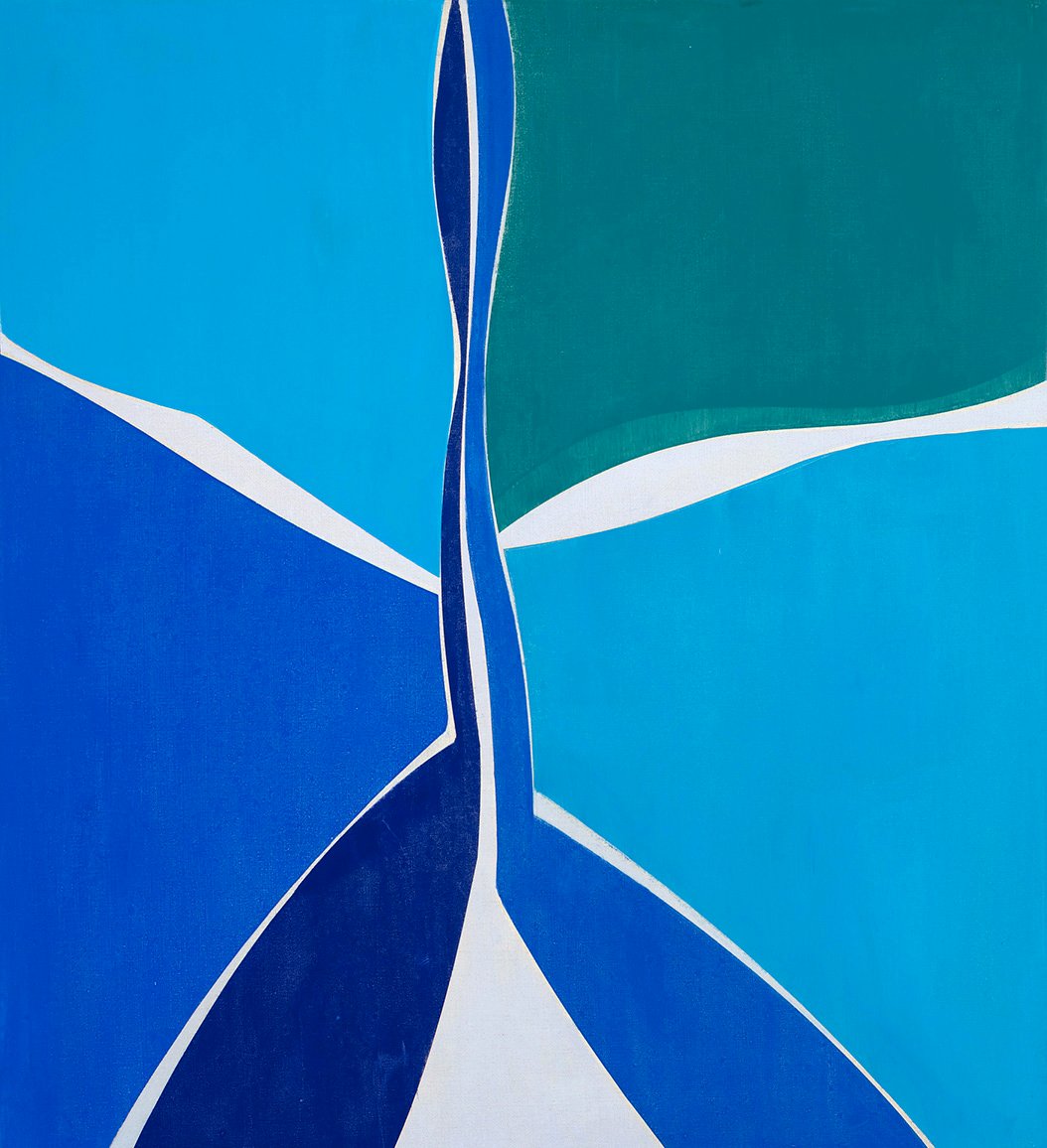“Art, whatever it takes”
The RomeArtProgram has made a series of interviews with Artists living in Italy, the USA & the UK
to know their feelings and orientation during these times of emergency.
Joanne Freeman – New York Artist – Vice President of American Abstract Artists.
Joanne is represented by Kathryn Markel Fine Arts-NY, and has been a Visiting Artist to the RomeArtProgram.
RomeArtProgram: Where do you live ? And what is your background?
Joanne: I live in New York City, and grew up in the suburbs of Boston Massachusetts. As a teenager I took art lessons at the Museum of Fine Arts in Boston and frequently visited the Rose Art Museum at Brandeis University. The Rose Art Museum had an incredible collection of contemporary American art which included Andy Warhol, Jasper Johns and Robert Rauschenberg. That early exposure to American masterpieces was the impetus for my painting career. I attended the University of Wisconsin for an under graduate degree in Fine Arts and later, New York University for an M.A in studio Art.
RAP: In your opinion is there a “creative method”?
Joanne: I think you are referring the creative process which is different for every artist. I create systems for myself in the studio which lead to series, with one work informing the next. Ambient stimulus and thoughts enter all the time, sometimes creating successful transitions and sometimes not.
RAP: The “lock down moment” can set you on the path of some important change(s) in your creativity and style …Has this happened to you?
Joanne: Somewhat, I’ve been living and working outside of New York City for the last 4 months. I enjoy working in the country versus the city as it’s quiet and I’m less distracted, but because of space restrictions I can only work on paper. Since I really create my own world in the studio no matter where I am, the true measure of this lock down moment will probably not manifest itself until I return to the city and begin working large again with oil on canvas.
RAP: What normally inspires you? Which is the most important inspirational source you have found in Rome?
Joanne: Urban culture inspires me. That includes art seen in museums and galleries by my peers, media, music, film, fashion and art history. Rome’s culture, both ancient and modern co-existing side be side is unique. It’s a world unto itself and you can feel it’s pull on the drive in from the airport. I love the anticipation and first view of Rome and the Colosseum from outside its walls. Once inside, the Pantheon is a source of inspiration with its austere geometry and perfect proportions, but it’s the colors of Rome that inspire me the most. The orange and red pants on the men, the patterned dresses on the women and ceremonial colors of blood red and deep purple found in and on the clergy.
RAP: Is there a difference in working in Rome for an artist? What art medium do you prefer to work in?
Joanne: I haven’t worked in Rome as an artist but I have worked in Otranto Italy for an extended period of time. That experience of working in an Italian coastal town had a profound effect on my work. I was influenced by the beautiful coastal light, the shadow play on the buildings and the saturated patches of color that appeared randomly against the white facades.
RAP: Specific events and historical conditions have a significant role in the creative process; how does this pandemic emergency affect the Arts?
Joanne: As with the rest of society the art world was already becoming more virtual. The pandemic has pushed that occurrence to the forefront of everyone’s consciousness as galleries and museums have had to close and art fairs have been cancelled. There are good and bad aspects to this situation. Access to art on line has helped to democratize the art world, as the business of selling art has become more transparent. Artists living outside of urban centers now have more opportunities to view and sell work, creating a global community of artists, dealers and art enthusiasts. On the negative side, the experience of viewing work virtually is not comparable with the physical experience of viewing work live, and virtual communities do not provide the support and free exchange of ideas that social gatherings and communities deliver. However interesting it is to view the work of an artist in Berlin, while sitting in New York, it doesn’t make up for the indefinable buzz that some live exhibitions create. Art is a by product of human experience, and all though its practice can be solitary, it’s content feeds on social interaction. It has and always will be the bedrock of every great city.
RAP: How are you feeling at this difficult moment and what made you feel this way? …are you optimistic for the future?
Joanne: I am optimistic for the future. The lockdown has created a pause which hopefully will be lifted soon.
RAP: What can Art contribute to history? Will “Art save us”?
Joanne: Art is entwined with history and is part of the progression of great civilizations. On a personal level the making of art is part of my identity and has always represented a higher purpose or unobtainable goal. Its a constant quest, as the best work is always slightly out of reach.
RAP: What is your most ambitious dream?…and the greatest sacrifice that you have made for your Art?
Joanne: Some of my ambitions have been realized which is to continue to make art and exhibit along with my peers, that I admire and respect. It’s not easy for anyone to make a career for themselves as an artist. I do feel that it has been harder for women artists to succeed financially within the current gallery system. Hopefully that’s changing as the work of women artists gain more exposure and financial value.
RAP: Recently, the artistic and cultural message of Italy and Rome was reemerging as a great “work in progress” …is this your point of view?
Joanne: I’m unsure what that message means, but the unique mix of ancient art, religion, architecture, fashion and design are a perfect storm for continued influence and relevance.
RAP: Which is your favorite Italian, or Roman, place(s) of art (Museum, Gallery, Monument…) ?
Joanne: The Museo Nazionale di San Marco in Florence is my favorite museum. Originally built and used as a monastery, in the fifteenth century, the architecture is perfectly balanced and austere. Fra’ Angelicos frescos adorn the walls of the monks cells and hallways. The integration of two dimensional art with three dimensional space is in perfect alignment to the point where the painter created trompe l’oeil features of imaginary windows and doors within the frescos themselves. The scale of the building is small, and the figures within the frescos are of human scale. There is no excess adornment on the white interior and exterior walls. Standing eye level before a Fra’ Angelico fresco in this context feels like a modern celebration of mankind. The soft touch and perfect proportions is a spiritual revelation.
RAP: Which period of Italian Art do you prefer? What is your favorite Italian work of art?
Joanne: The early Renaissance is my favorite period of Italian Art, particularly the work of Giotto. I am attracted to the seemingly flat painting space, overlapping forms and reductive shapes and figures, many of the same qualities found in contemporary abstract painting. I am an admirer of the modern architecture, design and graphics of Gio Ponti and more recently I have been appreciating the artists that emerged during and after the Arte Povera movement in the late 1960’s and early 70’s, specifically, Piero Dorazio and my favorite, the paintings of Carla Accardi.
RAP: How has Rome personally influenced you as an artist and a person?
Joanne: Rome is a visual and sensual experience. The integration of ancient ruins, religious pageantry and modern life is a constant reminder of where you’ve been and who you are. I’ve visited intermittently at different turning points in my life always with the thought of when I will return and perhaps one day live here. Like most Americans, the Rome I envisioned looked a lot like a Fellini movie, and somehow visiting did not entirely disappoint. The majority of my Rome visits were orchestrated by Carole Robb, always an insiders adventure and always memorable. I think of Rome as a reality check, a reminder and a reboot. I’m sure I will be returning soon.
RAP: What’s your goal? What role does the artist have in society? Any final thoughts and advice?
Joanne: Art should be part of your life, not separate. It’s an extension of who you are. One of the reasons I became an artist is because of the other art students in school, they were the people I liked. Art is about human connections. Find your community and keep working.
WebSite : www.joannexfreeman.net
Insta : joannexfreeman
The RomeArtProgram is ready to bounce back!
_______________________
RomeArtProgram
#romeartprogram
Art-as-Power


